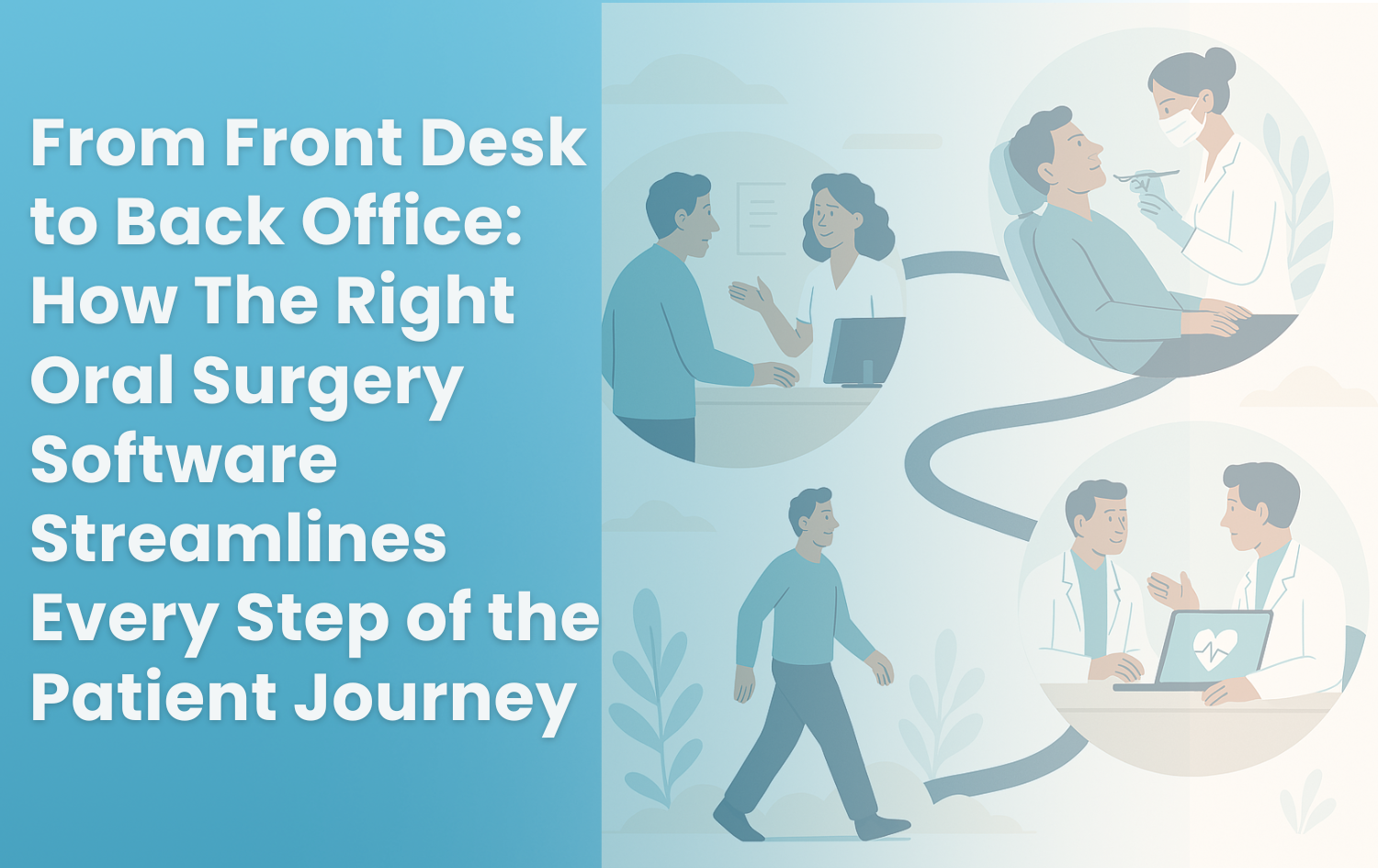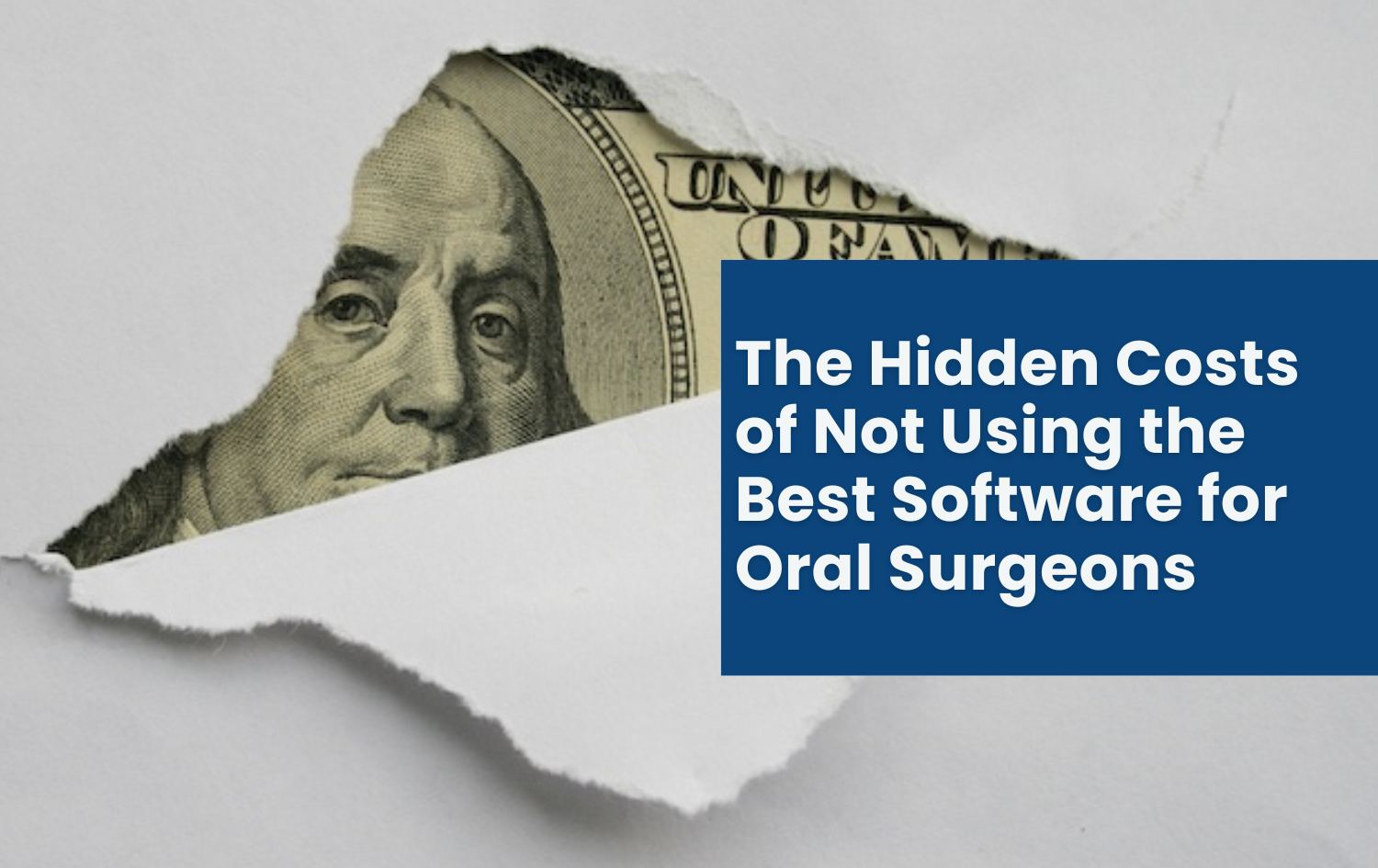Blog Overview
From Front Desk to Back Office: How The Right Oral Surgery Software Streamlines Every Step of the Patient Journey
Written by: Isaac Shapot, Marketing Director, DSNImagine walking into an oral surgery practice on a Monday morning. Phones are buzzing, patients are trickling in—some clutching coffee, others clutching nerves—and the front desk is already in high gear. It’s a scene that plays out daily, a whirlwind of activity that somehow has to feel calm and welcoming. How does it all come together? That’s where oral surgery software steps in, threading the needle from that first greeting to the final follow-up. It’s not just about keeping the chaos at bay—it’s about making every step of the patient journey smoother, for everyone involved. Let’s take a stroll through it, from the front desk to the back office, and see how this tech pulls it off.
First Impressions: The Front Desk Hustle
You’ve got Sarah at the front desk—smiling, of course, but her brain’s running a marathon. She’s checking in a patient, verifying insurance, and eyeing the schedule, all while the phone’s chirping in her ear. Without the right tools, it’s a juggling act that could drop a ball any second. But with oral surgery software? It’s a game-changer. Take a system like DSN, for instance. Sarah pulls up a patient’s profile in seconds—name, history, insurance details, all right there. No rifling through a filing cabinet or praying the printer didn’t jam again.
The software doesn’t just stop at organization. It’s got her back with real-time insurance checks, flagging any coverage hiccups before the patient’s even in the chair. Scheduling’s a snap too—open slots glow on the screen, tailored to procedure times, and a quick click sends a text reminder to the patient’s phone. Suddenly, Sarah’s not just keeping up; she’s ahead of the curve. And here’s the ripple effect: when she’s not frazzled, the patient feels it. They walk in, see a calm face, and think, “Okay, I’m in good hands.” Ever wonder how much that first vibe matters? It’s huge.
Into the Chair: The Handoff That Counts
Now the patient’s moving from the waiting room to the treatment chair. This handoff can be a weak link—think scribbled notes or a game of telephone between staff. I heard about a practice once where a patient’s penicillin allergy got lost in the shuffle. Yikes, right? That’s the kind of slip-up that keeps you up at night. Oral surgery software bridges that gap. With something like DSN’s cloud platform, the patient’s digital file tags along—no paper, no guesswork. Allergies, X-rays, past procedures—it’s all on the surgeon’s tablet, clear as day.
This isn’t just about avoiding disasters. It’s about flow. The clinical team picks up exactly where the front desk left off, no need to double-check or holler across the office. For the surgeon, that’s precious time saved—time they can spend focused on the patient, not chasing details. And let’s be real: oral surgery’s already a high-stakes gig. Patients are trusting you with their faces, their comfort. When the tech keeps things tight, it’s one less thing to worry about—for them and for you.
The Main Event: Surgery Time
Here we are, in the thick of it—lights on, tools ready, patient prepped. You might think oral surgery software takes a breather here, letting the surgeon’s skill shine. Not quite. It’s still in the mix, just quieter. Before the first cut, systems like DSN have already laid the groundwork. Those 3D scans from a CBCT machine? Loaded in, mapped out, showing nerve lines and bone angles for a tricky implant or extraction. It’s like a cheat sheet for precision, cutting down on surprises mid-procedure.
During the surgery, it keeps humming along. Assistants can log vitals or meds in real time—DSN, for example, syncs with monitoring devices, jotting down numbers every five minutes without anyone lifting a pen. That’s not just slick; it’s a safeguard. Accurate records, no scribbles to decode later. I’ll confess, I find this part oddly satisfying—tech and talent teaming up like that. It’s practical too. Fewer hiccups mean the patient’s out of the chair faster, feeling good, and the day stays on track. Who doesn’t love a win like that?
Post-Op: The Back Office Groove
Surgery’s done, the patient’s groggy but grinning (or trying to), and now the back office steps up. This is where the unsung heroes—billing, follow-ups, compliance—keep the wheels turning. Without oral surgery software, it’s a slog. Claims get tangled, follow-ups slip, and HIPAA looms like a storm cloud. But with the right system? It’s a different tune. DSN, for one, auto-fills billing codes—CDT and ICD-10—straight from the procedure notes. No more guessing if D7210 matches the extraction or cross-referencing a manual.
Claims zip off electronically, tracked in real time, and denials get flagged before they fester. Meanwhile, the software schedules that post-op check, sends the patient a care rundown—ice packs, pain meds, the works—and logs it all for compliance. It’s like a second brain, catching what humans might miss. Why’s this a big deal? Because screw-ups here don’t just cost cash—they chip away at trust. A surprise bill or a missed call can sour a patient’s whole experience. Oral surgery software keeps that bond solid, letting the team focus on care, not cleanup.
Tying It Together: The Full Journey
Zoom out for a minute. From that first “hello” at the front desk to the last chart entry, oral surgery software is the glue. It’s not about replacing people—it’s about connecting them. Front desk, clinical crew, back office—they’re not separate islands anymore; they’re a team, synced up. DSN’s cloud setup, for instance, keeps data live across locations, so a patient’s file is the same whether they’re at Office A or B. No lag, no duplicates—just smooth sailing.
And it’s not stuck in time. These systems grow with you. Take DSN’s patient portal—patients can peek at their records or book online, a nod to how we live in 2025. Or think about spring, when wisdom tooth season hits. The software balances that rush, shuffling staff and slots like a pro. It’s those little flexes—adapting to the real world—that make it a must-have.
The Feel-Good Factor: Why It Hits Home
Let’s get honest. Running an oral surgery practice is no picnic. The pressure’s on—patients are anxious, the team’s stretched, and you’re the one steering the ship. So when oral surgery software steps in, it’s more than efficiency—it’s relief. Sarah’s not drowning in calls. The surgeon’s not sweating the small stuff. The back office isn’t playing catch-up. There’s space to breathe, and that’s gold.
For patients, it’s even deeper. A seamless journey—no billing shocks, clear next steps, quick recoveries—builds faith. They’re not just cases; they’re people who’ll tell their friends, “That place? They’ve got it together.” Ever had a procedure go so smooth you almost forgot the stress? That’s the target. And for the team, it’s a morale boost—less grind, more purpose. Who wouldn’t want to work in a place that hums like that?
Looking Ahead: The Bigger Picture
So where does this land us? Oral surgery software isn’t just a nice-to-have—it’s the heartbeat of a practice that thrives. It takes the patient journey, with all its mess and magic, and turns it into something smooth and reliable. From the front desk’s friendly “hi” to the back office’s final click, it’s the steady hand keeping everything in sync. Systems like DSN nail it—built specifically for oral surgery, not some one-size-fits-all patch, tackling workflows, billing, and more with quiet precision. Ready to see it in action? Book a demo with DSN today at dsn.com or call (800) 366-1197—because a practice this good shouldn’t wait.
Our Recent Blog Posts

From Front Desk to Back Office: How The Right Oral Surgery Software Streamlines Every Step of the Patient Journey
Imagine walking into an oral surgery practice on a Monday morning. Phones are buzzing, patients are trickling in—some clutching coffee,...
Read More
The Hidden Costs of Not Using the Best Software for Oral Surgeons
Imagine walking into an oral surgery practice on a Monday morning. Phones are buzzing, patients are trickling in—some clutching coffee,...
Read More